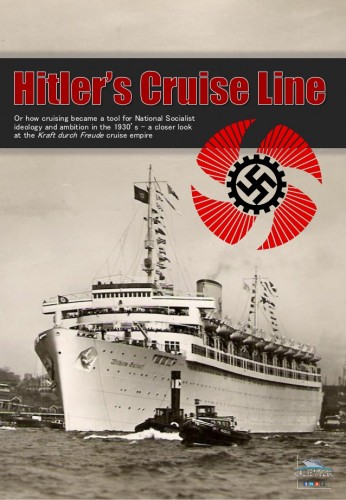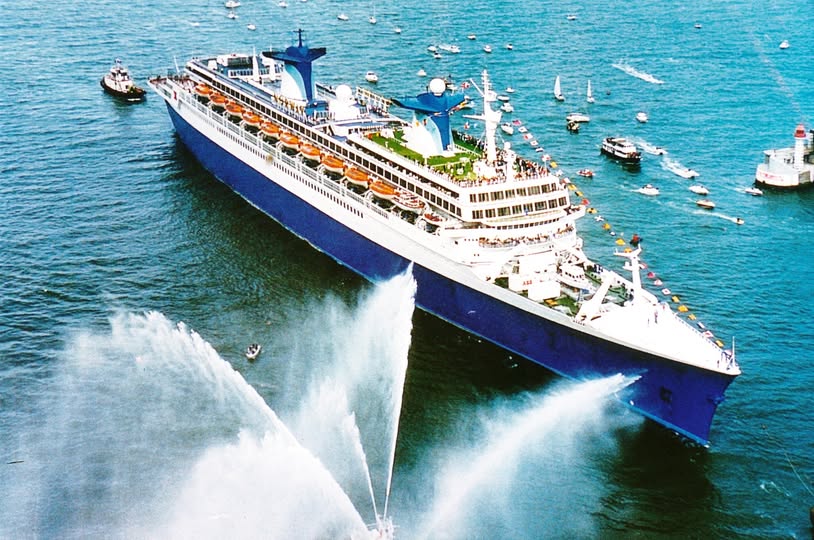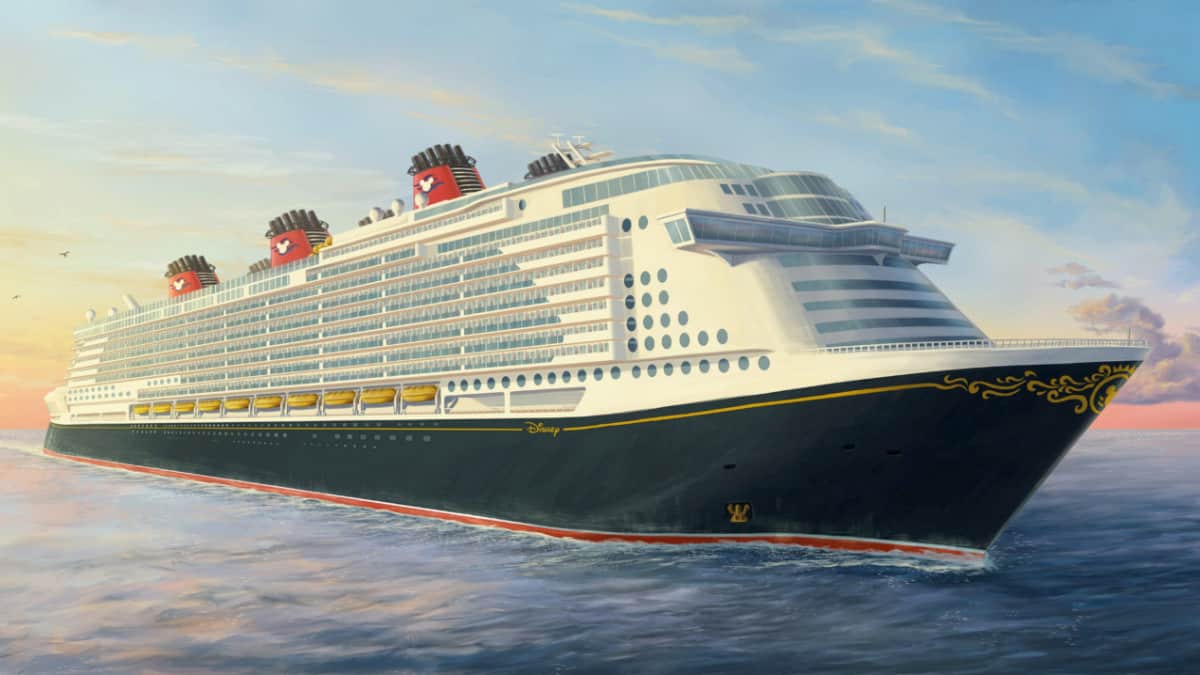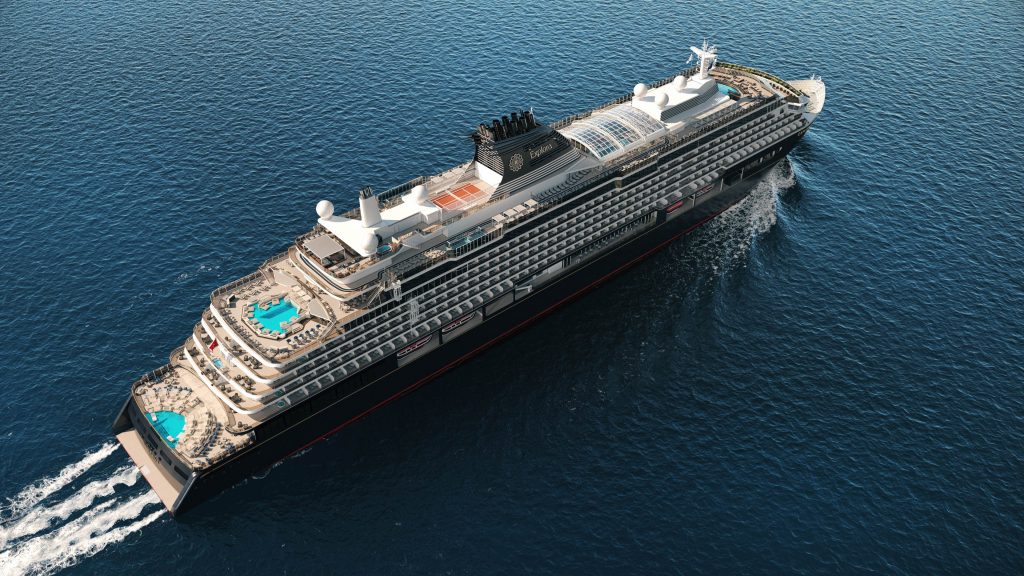

In Germany in the 1930’s., the National Socialist regime came to power. Immediately, the Nazi’s established the German Labour Front (Deutsche Arbeitsfront). In order to force the existing worker unions out of business, they established a propaganda division called Kraft durch Freude (Strength through Joy) offering the working class all kinds of attractive leisure activities. One of these resulted in the plan to build a fleet of passenger ships offering cruises, which up till now was not within the reach of the lower working class, which regarded cruising to be romantic and adventurous. Those who became members of the German Labour Front could join these cruises, which were very friendly priced.

Of course, organizing trips like these had some advantages for the Nazi’s, as they could feed propaganda to the ships’ passengers round the clock. Also, the ships could show the world the “more friendly face” of the Nazi regime.
At the time there were plans to build a fleet of up to 30 ships, but apart from chartered vessels, only two vessels were specifically built for the KDF-movement, the Wilhelm Gustloff (25.500GRT, 1465 pax) and the Robert Ley (27.300GRT, 1775 pax) named after the leader of KDF.
They were designed for cruising at slow speed, and had wide bulky hulls to provide as much interior space as possible.
Their interiors had to reflect the homes and taste of their passengers, so it had to be a cosy (gemutlich) and a bit austere and severe atmosphere, reflecting the conservative German society of the time.
It all had to fit in the Nazis’ general guidelines drawn up for interior design those days. However, also outside Germany, passenger ships operating at the time reflected this austere, dark and conservative interiors.


Waldemar Brinkmann, an interior architect of the neo-classical school designed the interiors of both vessels.
Public rooms were on the Promenade Deck. On both ships, simple and solid furniture and fittings were used. Wilhelm Gustloff was the more “simple” vessel of the two, the art onboard consisted mostly of romantic paintings of rural life and landscapes.
Brinkmann went a step further onboard Robert Ley, both main public rooms were 2 decks high, featuring balconies, balustrades some of which even showed swastika’s , the Nazi-symbol. Also, the only public space which was fitted with wood panelling, this artwork (paintings) in this salon also reflected the romantic side of life.
The Wilhelm Gustloff main social hall whith its all over severe atmosphere, also with its large bronze lamps and of course, being the focal point of the ship, the Fuhrers portrait was the ship’s focal point.

Both KDF-ships will be rememebered for their innovations, which had great consequences for passenger-cruise vessels built in later years: all cabins were outside cabins and were interlocked, the larger, having an L-form being wrapped around the smaller square cabins. Apart from this, all cabins on all decks were exactly the same in fittings and dimensions, built in series into all of the vssel’s decks. It took until 1984 before another AOC (all outside cabin) passenger ship, the P&O cruise ship Royal Princess would be taken into service. In this way, the Germans introduced series of equally fitted passenger cabins, like we see on most cruise ships today. Before that, passengers sailed in many different cabin layouts being available on the same ships with different grades of luxury. As a result of their socialist background, the Germans even went as far as accommodating the crew in cabins, fitted out equally to passengers staterooms.

Robert Ley
She was named after nazi politician Robert Ley and was taken into service in 1939, designed by architect Waldemar Brinkmann. She could carry about 1750 passengers on 10 decks, providing her passengers with a library, several lounges, dining rooms which could seat 860 in one sitting and a hospital.
Robert Ley was used for cruises Under the KDF-banner for only 6 months, until she was requisitioned by the Kriegsmarine and converted to a hospital ship. Again 3 months later, she was made suitable for living quarters for the 1st Submarine Training Division and this lasted until 1945. In between, in 1944 she sailed as a casualty transport ship in the Baltic Sea. On March 1945 she was in port in Hamburg while the Royal Air Force bommed the city and port. Robert Ley suffered several bomb hits and was completely gutted by fire. The hull remained in situ until 19147 when she was towed to Inverkeithing and scrapped.




Wilhelm Gustloff
Also intended for use as a KDF cruise ship was the Wilhelm Gustloff. Built by Blohm and Voss at a cost of 25 million Reichsmarks , she had length of 208 mtrs and measured 25.800 GRT. She was launched in 1937 and cruised for the KDF-organisation until 1939 as their flagship.
Wilhelm Gustloff was intended to be named Adolf Hitler, but Hitler decided for a name change after Wilhelm Gustloff – being head of the the Swiss branch of the Nazi party – was killed by a Jewish student Hitler sat next to his widow at his memorial service and decided it would be a fitting gesture to name the ship after Wilhelm Gustloff.
Like Robert Ley, also Wilhem Gustloff was converted to a hospital ship in 1939. After a year she was painted in wartime grey and saw further use as an accommodation ship for U-Booat trainees in the port of Gdynia, Poland. She sat in dock for 4 years, before being put back in service to take part in Operation Hannibal, transporting civilians and military personnel from Russia back to Germany as the Red Army advanced on the eastern front. On Wilhelm Gustloff’s last voyage, she was sailing from Danzig to Kiel. Official records state she carried 6,500 passengers, but later investigations conclude that there were probably over 10,500 passengers and crew onboard. After leaving Danzig on January 30, 1945 with four captains onboard, chief captain Petersen dicided to go for deep water although he was adviced otherwise by his fellow captains because of the risks the Wilhelm Gustloff would be running in open waters…. To avoid collision with other ships in the area, she was sailing with full navigational lights. Soon afterwards the Russian submarine S-13 sighted her and fired three torpedoes. The impact resulted in an electrical power black-out, leaving everyone below deck trapped in complete darkness in the quickly listing vessel. She sank in 50 minutes, her list preventing lifeboats on the starboard side being lowered. Many of her remaining lifeboats had to be cut free as they had frozen solid in their davits. German ships in the vicinity could only rescue a 1000 persons from the ice cold water with air temperatures between -10 and -18 degrees celsius.
With 9,500 casualties (several different figures are mentioned as there was no reliable ship’s manifest), this is by far the greatest loss of life in maritime history, being over 6 times as high as the 1,503 passengers and crew who perished earlier in 1912 during the Titanic disaster.









